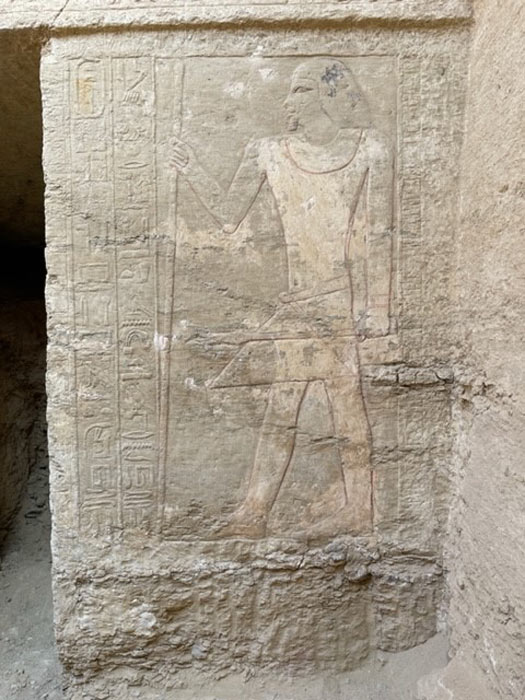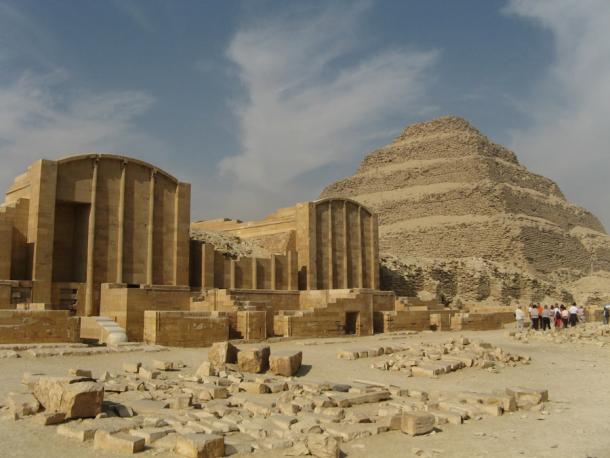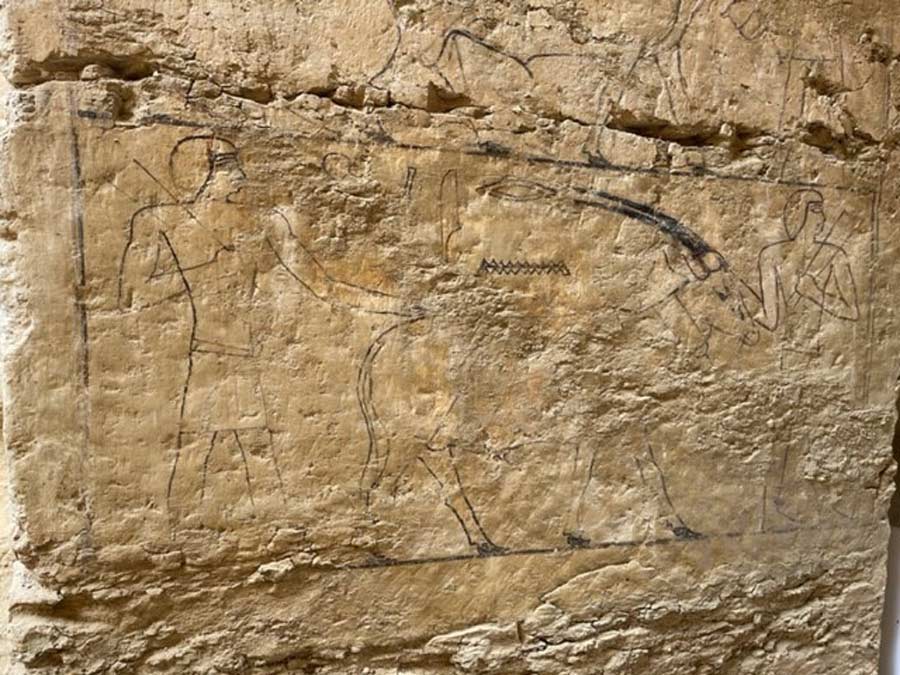Tomb of Egyptian Dignitary Who Guarded Top Secret Documents Found in Saqqara
A 4,300-year-old tomb has been discovered in the ancient Egyptian necropolis of Saqqara, which is that of an Egyptian dignitary who was responsible for guarding top secret documents of the pharaohs.
The tomb belonged to a man named Mehtjetju, as per the reliefs and hieroglyphic symbols on the walls and facade of the tomb. At the time that he was alive in 2300 BC, Mehtjetju was an elite Egyptian dignitary and court official with considerable status, as per a press release by the Polish Centre of Mediterranean Archaeology at the University of Warsaw.
Mehtjetju: The Unfinished Story of an Egyptian Dignitary
“The dignitary bore the name Mehtjetju and was, among other things, an official with access to royal sealed, that is secret documents, an inspector of the royal estate and a priest of the mortuary cult of King Teti,” explained the expedition director, Associate Professor Kamil O. Kuraszkiewicz from the Faculty of Oriental Studies at the University of Warsaw. “This means that he most likely lived during the reigns of the first three rulers of the Sixth Dynasty: Teti, Userkare and Pepy I, and thus at about the same time as Merefnebef,” added the Egyptologist.
- The Old Kingdom of Egypt – Dynasties That Changed the World
- Major Discoveries of Coffins, Burial Shafts and Texts Made in Saqqara
This discovery of this official during the reign of the first pharaohs of ancient Egypt’s Sixth Dynasty (2345-2181 BC) was made accidentally by the team of archaeologists while excavations were being conducted within the Dry Moat. The Dry Moat encircles King Djoser’s 4,700-year-old Step Pyramid, and this find from the autumn of 2021 was just west of the tomb of Wazir Merefnebef, also discovered by the same PCMA UW expedition.
The Smithsonian reports that the Egyptian dignitary’s duties included guarding access to the secret documents of the royal chancellery, acting as inspector of the royal estates, and priest of the mortuary cult of King Teti. His death was allegedly unexpected, deduced by a hasty decoration of the burial site. They could not finish carving the decorative reliefs of sacrificial animals on the outer facade, because they ran out of time. The remains of sketches in black ink on lime plaster, with reliefs depicting cows, oryxes, and ibexes, were found. However, the researchers believe that Mehtjetju was nevertheless buried “properly.”

An image of Mehtjetju, the elite Egyptian dignitary, found in his newly discovered tomb at Saqqara. (Polish Centre of Mediterranean Archaeology, University of Warsaw)
“If he had not been buried there, the tomb would most likely have been taken over by someone else,” Kuraszkiewicz said in the university press release. “The decoration is unfinished probably because the investor died before the work was completed and was buried in the hastily finished tomb.”
A marker of his proximity to the elite corridors of power and his social status is witnessed by the fine work performed on his burial place. It was clearly the work of a very gifted and skilled crew. “The elegance of the lines and subtlety of the modeling rival the best reliefs in the vizier’s tomb,” the archaeologists said. As the rock in the chapel surrounding the tomb was very brittle, experts from Warsaw’s National Museum helped with immediate relief and conservation.
There was no polychromy (a preservative material) found on the facade, which could have acted as a draft for the reliefs to be carved. “It is possible that it was never created because the decoration of the chapel was not completed. The side walls of the entrance have no relief decoration, just figures painted in black ink on lime plaster,” added Kuraskiewicz.

The Egyptian dignitary’s tomb was found in at the edge of the Step Pyramid of King Djoser at Saqqara pictured here. (PB / Adobe Stock)
Saqqara and the Proximity to Power
In an email exchange with Live Science, Kuraszkiewicz noted that it was not surprising that the burial was near King Djoser. Djoser’s legendary Step Pyramid was the first of its kind at Saqqara, and he was an extremely important and revered king in Egyptian history. A lot of Egyptian officials, even after his death in 2575 BC, continued to want to be buried next to Djoser in a bid to heighten their status.
- Elites and Gods: The Big Lives Of Little People In Ancient Egypt!
- The Magnificent Step Pyramid of Djoser in Saqqara – Now Open!
Saqqara has witnessed its archaeological value rise in recent years. For long, the focus was on the ancient capital Memphis, which would then later shift to Alexandria. And Luxor and the Great Pyramids have been the traditional headline grabbers for tourists and archaeologists alike. Archaeological expeditions and ensuing efforts focused their energies in these two important centers.
Since 1987, the Polish-Egyptian mission has shifted its focus to this area of the ancient necropolis of Saqqara, west of the Step Pyramid, which served as a burial ground for 3,000 years. The necropolis, with a 5 mile (8.04 kilometer) radius, a few kilometers south of Cairo on the west bank of the Nile, is home to the remains of tombs, temples, and walkways, integral to the reconstruction of the history of ancient Egypt.
Dr. Mostafa Waziri, the secretary-general of the Supreme Council of Antiquities of Egypt, has often remarked that Saqqara has not yet been explored even to ten percent of its full capacity. The current team plans to resume excavations in the fall of 2022, when they will uncover the tomb and mummy of Mehtjetju, the elite Egyptian dignitary who kept the Pharoah’s secrets until his death.
Top image: The black ink outlines on the exterior of the Egyptian dignitary’s tomb recently found at Saqqara indicate that his grave was likely never finished properly. Source: Polish Centre of Mediterranean Archaeology, University of Warsaw
By Sahir Pandey
References
Aszy. 2022. Saqqara: discovery of a royal official’s tomb. Available at: https://pcma.uw.edu.pl/en/2022/05/09/saqqara-discovery-of-a-royal-officials-tomb/.
Aton, F. 2022. Archaeologists Have Unearthed the 4,300-Year-Old Tomb of an Ancient Egyptian Dignitary. Available at: https://www.artnews.com/art-news/news/ancient-egyptian-dignitary-tomb-unearthed-saqqara-1234629227/.
Jarus, O. 2022. Tomb of ancient Egyptian dignitary who read top secret documents discovered. Available at: https://www.livescience.com/ancient-egyptian-tomb-royal-official.
Kuta, S. 2022. Archaeologists in Egypt Unearth 4,300-Year-Old Tomb of Man Who Handled His Pharaoh’s ‘Secret Documents’. Available at: https://www.smithsonianmag.com/smart-news/archaeologists-egypt-unearth-4300-year-old-tomb-of-egyptian-dignitary-who-handled-secret-documents-pharaoh-180980120/.
Lawsen-Tancred, J. 2022. Archaeologists Have Discovered the 4,000-Year-Old Tomb of an Egyptian Dignitary Who Guarded Royal Documents. Available at: https://news.artnet.com/art-world/royal-officials-tomb-discovered-egypt-2117718.



















